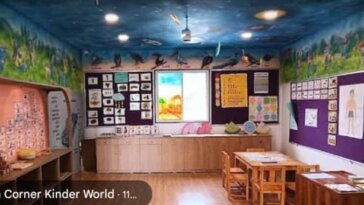Indoors
Indoor Curiosity Approach settings are filled with authentic, open-ended resources. Think old clocks, metal tea sets, dried fruit in bottles, unique jewellery boxes, serving trays, kitchen utensils, and shells, stones, and dried fruit in glass jars – objects that children can explore and investigate.
The co-founders understand that children will learn and engage with resources in different ways. Each resource is full of possibility and wonder. Dressing up areas, for example, should be filled with items to provoke interest and intrigue, rather than synthetic items which merely reinforce societal stereotypes. Think old hats, walking sticks, handbags, old telephones, and vibrantly coloured embroidered slippers. Surround displays with texts and unique photographs or art work linked to the items. These areas are there to develop children’s imagination, literacy, and social skills.
Hellyn and Bennett suggest that providers reach out to parents, carers, and members of the local community for support in stocking and replenishing their curiosities. They also advocate posting requests on community message boards, looking in charity shops, and searching through car boot sales.
Outdoors
The Curiosity Approach champions every aspect of outdoor learning. Whether it be bug hunting, digging in the sand, planting seeds in old tyres, climbing, rolling, or den making, there are so many ways to develop children’s talents and interests whilst outdoors. In Curiosity Approach settings, you’ll find unique play areas for the children to explore. Their hay bale and pallet tables bring innumerable learning opportunities. Children have access to cutlery and crockery to host tea parties. They can even use real microwaves (unplugged, of course) rather than pretend ones to ‘warm up’ their ‘self-created food and drinks’.
Hellyn and Bennett believe that children love emulating adults in their play, so opting for real plates, toasters, and microwaves is preferable over miniature plastic versions. They stress that adults must model the play, so that children learn how to respect and value the objects they’re using.
Old sheets can be draped across their outdoor tables – acting as a giant canvas for all the children to contribute to. You’ll also find old trunks filled with curiosities throughout their outdoor settings. Each of these activities provide endless play opportunities, as well as developing each of the skills set out in the national curriculum, particularly the strengthening of the children’s fine and gross motor skills.
Recycled materials
It should come as no surprise that The Curiosity Approach are advocates of salvaged, recycled materials. They want children to develop a deep love and respect for their world, by playing with natural materials. For example, when painting, children can use pinecones and leaves to create and experiment with different patterns and textures.
Providers can also encourage children to collect materials that interest them, and bring them in for their friends to explore too. Think conker shells, unusual fruit and vegetables, and crisp red autumnal leaves.
Charities such as The Salvation Army and Toys4Life are helping to fight the global problem of plastic waste, by providing toys for children in deprived parts of the world. They also offer school and nursery collections to any providers who are looking to donate unwanted plastic toys or resources.
Words and Stories
As well as having an inviting reading corner, make sure the environment is as language-rich as possible. Stories and writing should be accessible everywhere. Children should be surrounded by poems, songs, and rhymes, as these are ways of introducing and reinforcing new language. Book shelves and displays can easily be formed using recycled materials, such as plastic drain pipes, and reclaimed wood.
Parental Support
Hellyn and Bennett stress the importance of linking learning to the child’s needs and interests. A great way to do this is to engage with parents or carers on a regular basis to find out what is sparking the child’s curiosity at home. Providers can send a sheet home every 6-8 weeks to find out what the child is enjoying, which special occasions they’ll be celebrating soon, and which parts of the community have they visited. You might find out that a child has developed a love of the ocean following a visit to the aquarium, so you might then map out some provocations focusing on sea creatures, and investigating uniquely textured shells in the sand. Select a story stimulus to further develop the child’s love of the sea. Furthermore, if parents upload photographs to your provision’s learning portal, print off some pictures of the child enjoying the aquarium. This will help to strengthen links between home and nursery, as well as developing the child’s confidence within the setting. Surround the images with fairy lights and blow some bubbles around the provocation to stimulate further curiosity.








